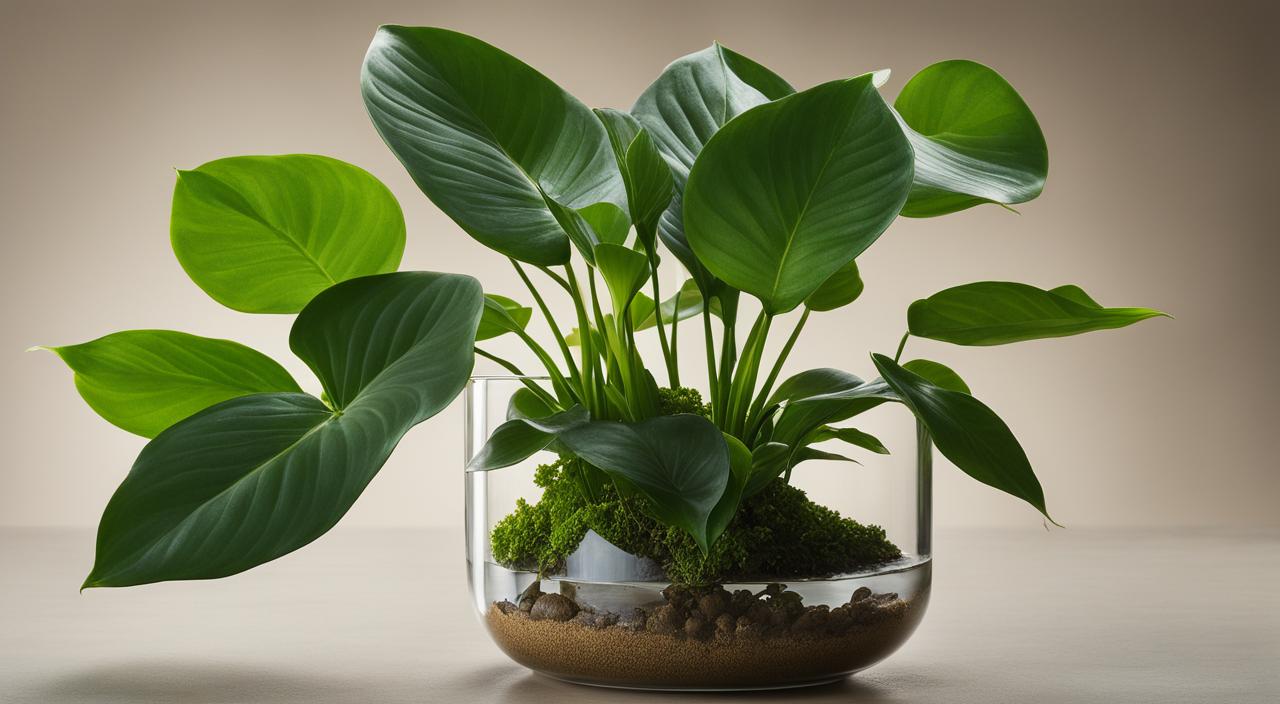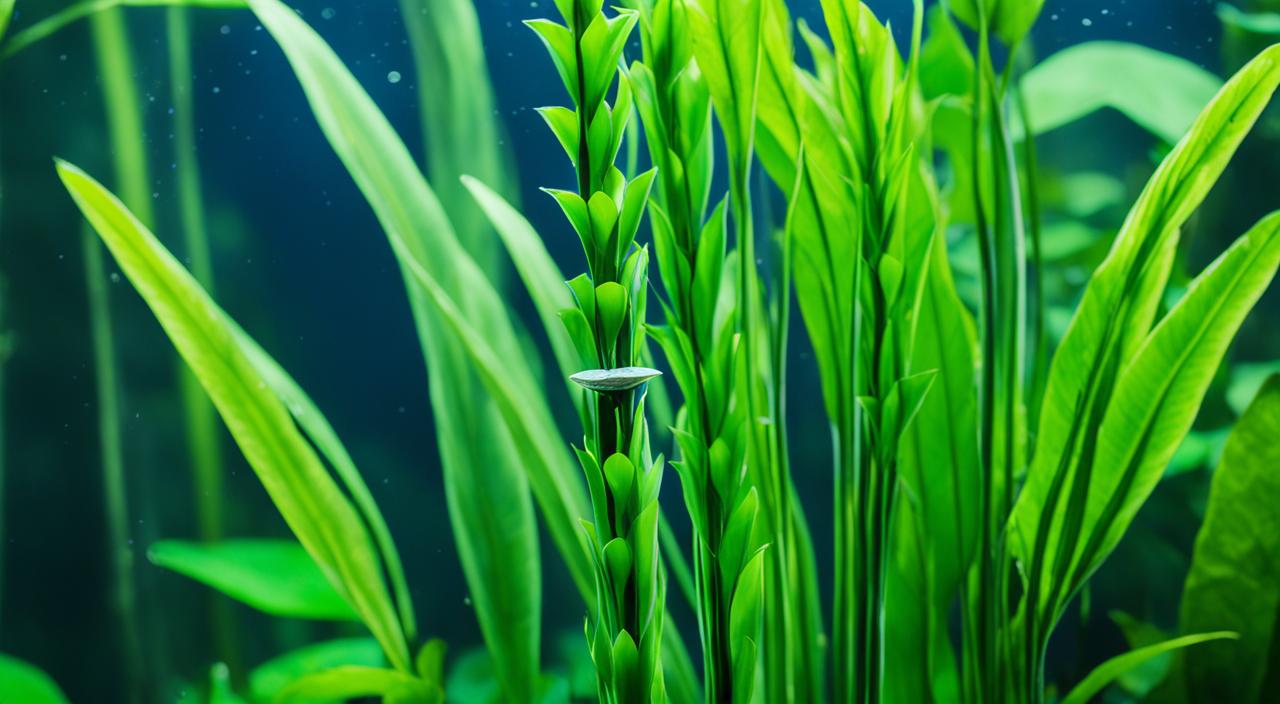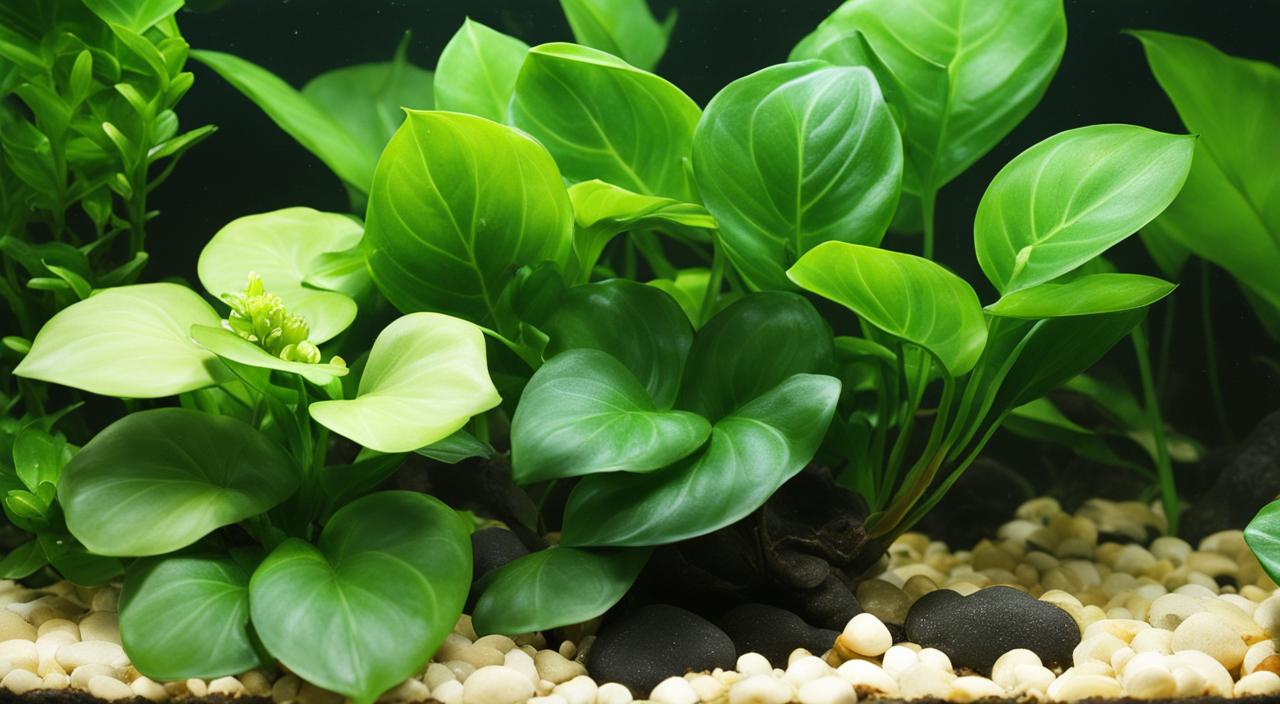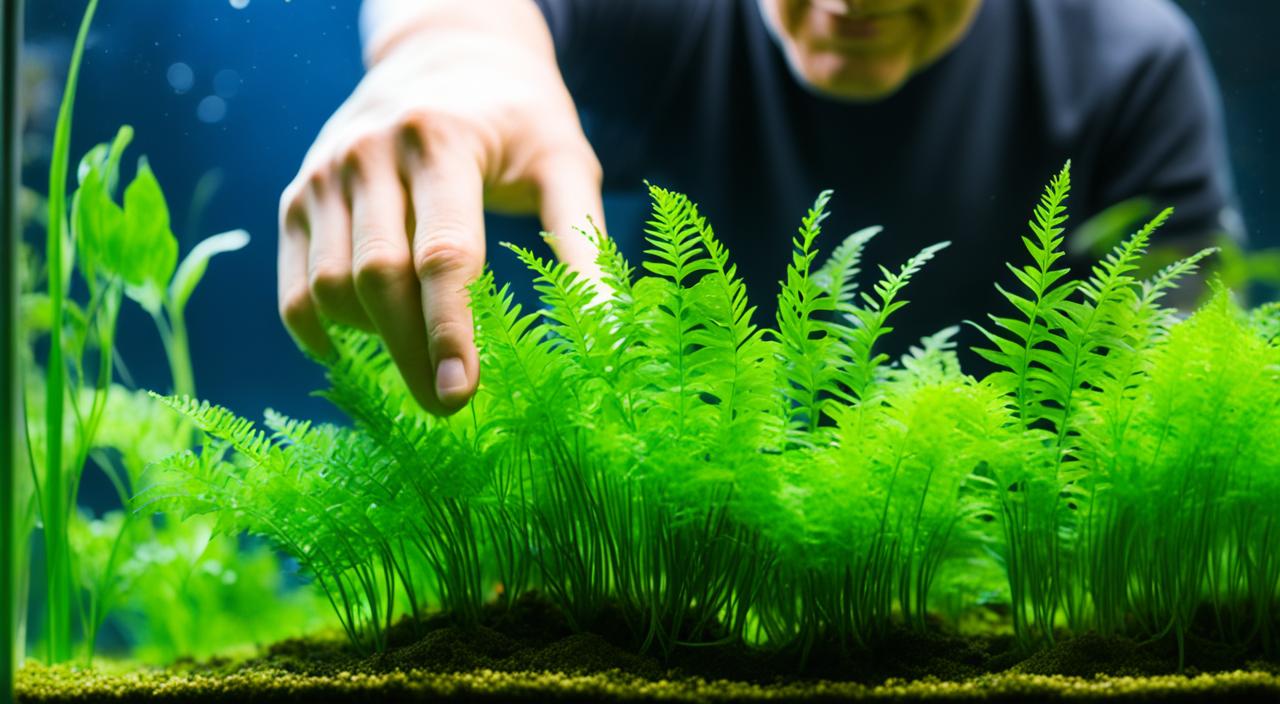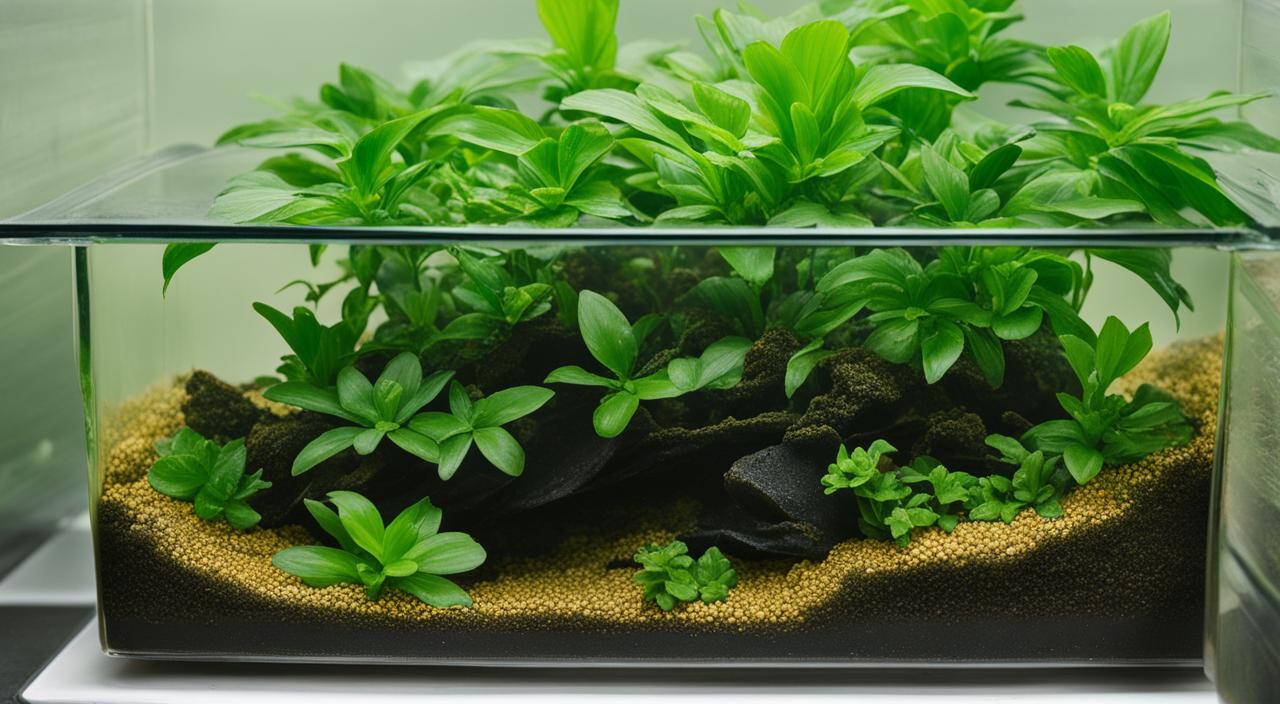Welcome to my guide on Anubias Coffeefolia, a stunning variety of aquatic plants that is renowned for its lush, green leaves. If you’re a fan of low-light aquarium plants and want to add a touch of natural beauty to your tank, Anubias Coffeefolia is a fantastic choice. In this article, I will provide all the essential information and tips to care for this plant successfully and create a thriving aquatic environment.
Key Takeaways:
- Anubias Coffeefolia is a variety of the common Anubias Barteri, known for its beautiful ruffled leaves.
- This plant is well-suited for low-light aquariums and requires low to medium lighting.
- Regular fertilization can enhance the growth and health of Anubias Coffeefolia.
- CO2 injection is not necessary but can promote faster growth.
- Propagation can be done by cutting or pulling apart the rhizomes.
Brief Overview Of Anubias Coffeefolia
Anubias Coffeefolia is a variant of the common Anubias Barteri, specifically known for its unique and textured leaves. It is a slow-growing plant that can thrive in low-light conditions, making it an excellent choice for beginners or those with low-light aquariums. The ruffled leaves of Anubias Coffeefolia can grow up to 3 inches long, adding a lush and vibrant touch to any tank. This plant is easy to care for and can adapt to various aquarium environments, making it a popular choice among aquarists. It can be propagated by cutting or pulling apart the rhizomes, and it’s essential to keep the rhizomes above the substrate to prevent rotting. Anubias Coffeefolia is a versatile and attractive plant that can enhance the aesthetic appeal of any aquarium.
Anubias Coffeefolia Information Table:
| Characteristic | Description |
|---|---|
| Scientific Name: | Anubias barteri var. coffeefolia |
| Common Names: | Anubias Coffeefolia |
| Origin: | West Africa |
| Height: | 15-25 cm (6-10 inches) |
| Growth Rate: | Slow |
| Colour: | Dark green leaves with a wavy texture |
| Aquarium Placement: | Midground to Background, attached to rocks or driftwood |
| Water Type: | Freshwater |
| pH: | 6.0 – 7.5 |
| Care Level: | Easy |
| Light Requirements: | Low to moderate, 50-70 PAR, 4000-7000K (Kelvin scale) for optimal color and growth |
| CO2 Requirements: | Low to moderate, 50-70 PAR, 4000-7000K (Kelvin scale) for optimal colour and growth |
| Temperature: | 22-28°C (72-82°F) |
| Flow Rate: | Low to moderate; prefers stable conditions with gentle water movement |
| Propagation: | It is not necessary but can promote faster growth |
| Feed Type: | Rhizome division or separating side shoots |
Origins And Habitat
Anubias Coffeefolia belongs to the Anubias genus, which is native to West Africa. It can be found in countries such as Cameroon, Nigeria, and Gabon. In its natural habitat, Anubias Coffeefolia grows along the banks of rivers and streams, attached to rocks or driftwood. These areas provide the plant with the ideal conditions of low to medium lighting, gentle water flow, and rich nutrient substrate.
In the aquarium setting, it is important to replicate these tropical conditions to ensure the health and growth of Anubias Coffeefolia. It is commonly used in aquascaping to create a natural and visually appealing underwater landscape.
Morphological Characteristics
Anubias Coffeefolia is easily recognizable due to its distinct morphological characteristics. This aquatic plant features long stems and ruffled leaves that can grow up to 3 inches long. The leaves have a deep green colour and a textured surface, resembling the shape of a coffee leaf. It is the unique appearance of the leaves that gives this plant its name, Coffeefolia.
The main structure of Anubias Coffeefolia is its rhizome, from which the leaves and roots grow. It is essential not to bury the rhizome in the substrate, which can lead to rotting. Instead, attach the rhizome to the aquarium’s rocks, driftwood, or other hardscape elements. The root system of Anubias Coffeefolia is relatively small and delicate compared to the size of the plant.
Overall, Anubias Coffeefolia is an attractive and unique plant that can add a touch of elegance to any aquarium.
Placement And Lighting
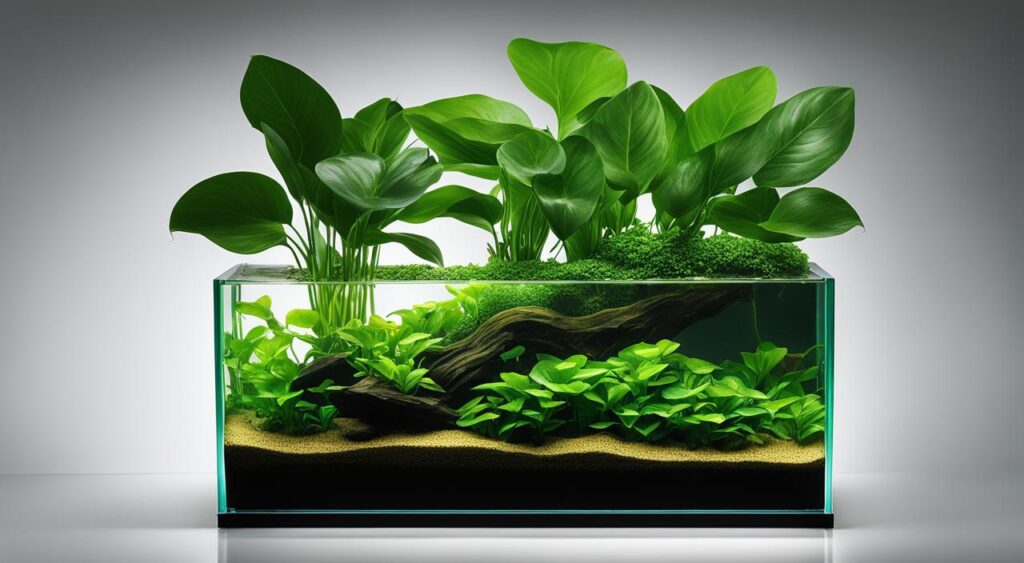
Anubias Coffeefolia is a versatile plant that can be placed in various locations within the aquarium. It is often used as a midground or background plant due to its size. The long stems and ruffled leaves create a lush and visually appealing backdrop for other aquatic plants and fish.
Regarding lighting requirements, Anubias Coffeefolia is considered a low-light plant. It can thrive in low and moderate lighting conditions, making it ideal for aquariums with limited natural or artificial light access. However, it’s important to note that high-intensity lighting can lead to algae growth on the leaves. Therefore, it is recommended to provide the plant with moderate lighting to maintain its health and appearance.
What Are Good Tank Mates?
Anubias Coffeefolia is a peaceful plant that can coexist with various aquarium fish and invertebrates. It’s an excellent choice for community tanks as well as species-specific setups.
Good Tank Mates
Good tank mates for Anubias Coffeefolia include small to medium-sized fish, such as tetras, rasboras, gouramis, and dwarf cichlids. Their calm and non-aggressive nature allows them to coexist with the plant peacefully. Additionally, Anubias Coffeefolia can provide shelter and grazing surfaces for shrimp, snails, and other invertebrates.
Fish Species To Avoid
On the other hand, specific fish species may not be suitable tank mates for Anubias Coffeefolia. These include large and aggressive fish species, such as cichlids, barbs, and some species of catfish. These fish may uproot or damage the delicate roots of the plant. It’s essential to research the temperament and compatibility of potential tank mates before introducing them to an aquarium containing Anubias Coffeefolia.
Feeding (Fertilization)
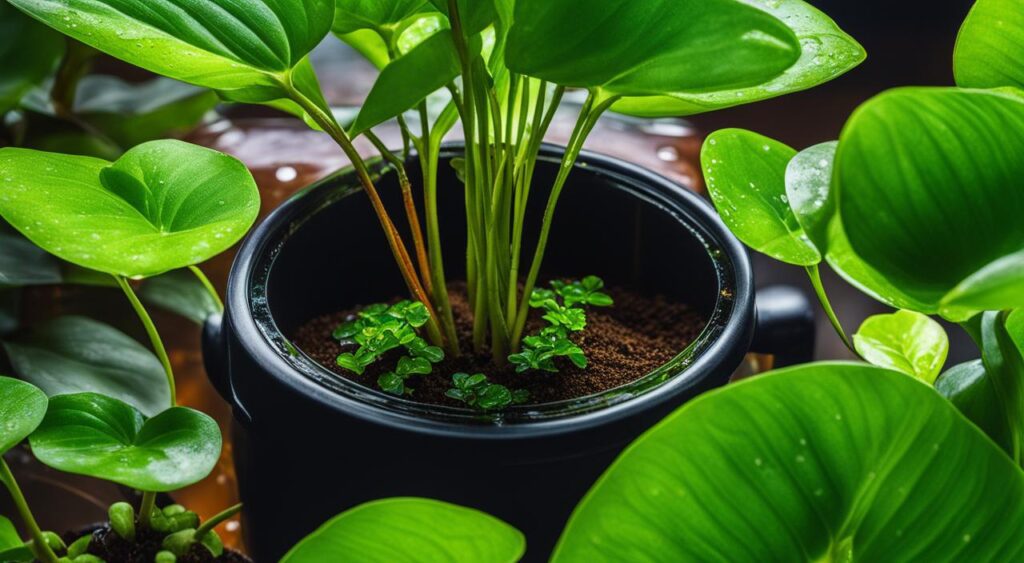
Anubias Coffeefolia is a relatively low-maintenance plant when it comes to fertilization.
It can derive nutrients from the water column and substrate, making additional fertilization optional. However, regular fertilization can enhance the plant’s growth and overall health.
Liquid aquarium fertilizers formulated explicitly for aquatic plants can be added to the water according to the manufacturer’s instructions.
Following the recommended dosage and avoiding over-fertilising is essential, as this can lead to nutrient imbalances and algae growth.
The frequency of fertilization can vary depending on individual tank conditions and plant growth rate. It’s recommended to start with a small dosage and adjust as necessary based on the plant’s response and the overall health of the aquarium.
CO2 Injection
CO2 injection is not necessary for the successful growth of Anubias Coffeefolia. This plant can thrive in aquariums without supplemental CO2. However, providing CO2 supplementation can promote faster growth and more robust leaves. There are different methods of CO2 injection available for aquarists:
Pressurized CO2 Systems
Pressurized CO2 systems, such as CO2 regulators and diffusers, provide a controlled and consistent release of carbon dioxide into the aquarium water. These systems typically consist of a CO2 cylinder, a pressure regulator, and a diffuser. The CO2 cylinder contains compressed carbon dioxide gas, which the diffuser releases into the aquarium. The pressure regulator allows for the adjustment of CO2 flow, ensuring that the correct amount of carbon dioxide is supplied to the plants.
Liquid Carbon Supplements
Liquid carbon supplements are an alternative option for CO2 supplementation in aquariums. These supplements typically contain glutaraldehyde or similar compounds that act as a carbon source for plants. Liquid carbon supplements can be added directly to the water, providing a source of carbon dioxide for the plants. They are an effective and convenient method of providing carbon supplementation for aquarium plants without pressurized CO2 systems.
The choice of CO2 injection method depends on the individual preferences and setup of the aquarium. Some aquarists may prefer the precise control and consistency offered by pressurized CO2 systems, while others may opt for the convenience and simplicity of liquid carbon supplements. Assessing the plants’ specific needs and the aquarium’s overall setup is essential before deciding on the most suitable CO2 injection method.
Care
Proper care is essential for the health and growth of Anubias Coffeefolia in your aquarium. You can ensure the plant thrives in its environment by providing the ideal parameters and maintaining good water quality.
Planted Tank Parameters
When setting up your aquarium, it is essential to consider the specific parameters necessary for Anubias Coffeefolia’s growth. These parameters include lighting intensity, duration, and temperature range. Anubias Coffeefolia can thrive in temperatures ranging from 72°F to 82°F (22°C to 28°C). Providing appropriate lighting levels and duration is crucial for the plant’s photosynthesis and overall health.
Water Quality
Maintaining good water quality is crucial for the health of Anubias Coffeefolia. Regular water changes should be conducted to remove any waste or toxins and maintain appropriate levels of nutrients. This helps prevent the build-up of harmful substances that can negatively impact the plant’s growth and overall well-being.
Filtration
Adequate filtration is vital in maintaining water clarity and preventing the accumulation of harmful substances. It helps remove debris and excess waste and promotes clean water circulation throughout the aquarium. Ensuring proper filtration creates a healthy environment in which Anubias Coffeefolia can thrive.
Flow
Anubias Coffeefolia prefers calm water conditions, so providing a gentle water flow in your aquarium is essential. Avoid strong currents that can uproot or damage the plant’s delicate roots. A well-regulated flow will create a serene environment that allows Anubias Coffeefolia to flourish and adds to the overall visual appeal of your tank.
| Parameter | Ideal Range |
|---|---|
| Temperature | 72°F – 82°F (22°C – 28°C) |
| Lighting | Low to moderate intensity 6-10 hours per day |
| Water Quality | Regular water changes Maintain appropriate nutrient levels |
| Filtration | Efficient filtration system to maintain water clarity |
| Flow | Gentle water flow Avoid strong currents |
Aquarium Maintenance
Testing Water Conditions
Regular testing of water conditions is crucial for maintaining the health of Anubias Coffeefolia and the overall well-being of your aquarium. Monitoring parameters such as pH, ammonia, nitrite, and nitrate levels is essential. These measurements will help you ensure that the water conditions are within the optimal range for the plant and its tank mates. Regular testing will also enable you to promptly detect any changes or potential issues. Adjustments can be made if necessary to maintain the ideal water parameters for your aquarium ecosystem and the successful growth of Anubias Coffeefolia. Remember to follow the instructions provided by the testing kits and record your results for future reference.
How To Set Up Your Aquarium Tank
Properly setting up your aquarium tank is crucial for the successful growth and maintenance of Anubias Coffeefolia. When placing the plant, it’s important to attach it to rocks, driftwood, or other hardscape elements using a fishing line or plant-safe glue. This will prevent burying the rhizome and causing rotting. Position the plant in a way that enhances your tank’s visual appeal while allowing adequate growth space. Consider the plant’s lighting requirements and ensure it receives the appropriate amount of light. Additionally, establish a suitable substrate and provide a stable and comfortable environment for your aquatic pets, ensuring compatibility with Anubias Coffeefolia.
Propagation Methods
Propagating Anubias Coffeefolia is an excellent way to expand the population of this beautiful plant in your aquarium. There are two standard methods of propagation: cutting and division. To propagate using the cutting method, carefully cut a healthy stem or rhizome from the parent plant using clean tools. Ensure each cutting has at least two or three leaves and a portion of the rhizome. Plant the cuttings in suitable locations, ensuring the rhizome is not buried in the substrate. To propagate through division, gently separate the rhizomes into individual sections, ensuring each section has its own leaves and roots. Replant the divided rhizomes in suitable areas of your aquarium. Handle the plant carefully during propagation to avoid damaging the delicate roots or leaves.
Health And Disease
Monitoring the health of Anubias Coffeefolia is crucial for ensuring its longevity and vitality in the aquarium. Here are some key points to consider:
Signs Of Good Health
Signs of good health include vibrant and green leaves, with new leaf growth and strong root development. A healthy Anubias Coffeefolia plant will exhibit lush foliage and show continuous growth.
Signs Of Poor Health
Signs of poor health in Anubias Coffeefolia may include yellowing or browning leaves, stunted growth, and decaying roots. These symptoms can indicate nutrient deficiencies, algae overgrowth, or fungal and bacterial infections.
Common Health Issues And Treatment
Some common health issues that can affect Anubias Coffeefolia include:
- Nutrient deficiencies: Lack of essential nutrients like iron, potassium, or nitrogen can lead to poor plant health. Adjusting water parameters and providing appropriate fertilization can help address these deficiencies.
- Algae overgrowth: Algae competition can hinder the growth and health of Anubias Coffeefolia. Regular maintenance, including light control and water changes, can help manage algae growth.
- Fungal and bacterial infections: Anubias Coffeefolia can be significantly susceptible to fungal and bacterial infections if the plant’s leaves or roots are damaged. Treating these infections with appropriate medications and removing infected parts can help control them.
Plant Pests
Anubias Coffeefolia can also be susceptible to plant pests such as snails, algae, and hitchhikers. These pests can damage leaves and inhibit healthy growth. Regular monitoring and preventive measures, such as quarantining new plants and maintaining good water quality, can help prevent and address pest issues.
Summary
In conclusion, Anubias Coffeefolia is a stunning, low-maintenance plant perfect for low-light aquariums. As a variant of Anubias Barteri, it features unique ruffled leaves that add a touch of elegance to any aquatic setup. This plant thrives in low to medium lighting conditions and can benefit from regular fertilization to promote healthy growth. While CO2 injection is unnecessary, it can accelerate the plant’s development.
Propagation of Anubias Coffeefolia is effortless and can be done by cutting or pulling apart the rhizomes. However, attaching the plant to hardscape elements is essential to prevent burying the rhizome and causing rot. Regarding tank mates, Anubias Coffeefolia is compatible with a wide range of peaceful fish and invertebrates, although larger and aggressive species should be avoided to prevent damage to the roots.
Maintaining the health of Anubias Coffeefolia requires regular aquarium maintenance, including monitoring water conditions, ensuring appropriate lighting, and providing gentle water flow. The plant is versatile and can be used as a midground or background, creating a lush and vibrant underwater landscape. With its lush green foliage and low-maintenance nature, Anubias Coffeefolia is a perfect choice for aquarists of all skill levels who want to add natural beauty to their aquarium.
FAQ
What is Anubias Coffeefolia?
Anubias Coffeefolia is a variant of the common Anubias Barteri, known for its unique ruffled leaves and lush green foliage.
Is Anubias Coffeefolia a low-light plant?
Yes, Anubias Coffeefolia is a low-light plant that can thrive in both low and moderate lighting conditions.
What are good tank mates for Anubias Coffeefolia?
Good tank mates for Anubias Coffeefolia include tetras, rasboras, gouramis, dwarf cichlids, shrimp, and snails.
What fish species should be avoided as tank mates for Anubias Coffeefolia?
Larger and aggressive fish species such as cichlids, barbs, and some species of catfish should be avoided as tank mates for Anubias Coffeefolia.
Does Anubias Coffeefolia require CO2 injection?
Anubias Coffeefolia can thrive without CO2 injection, but providing CO2 supplementation can promote faster growth and more robust leaves.
What are the care requirements for Anubias Coffeefolia?
Anubias Coffeefolia requires low to medium lighting, regular fertilization, and proper tank setup, including attaching the plant to hardscape elements.
How often should water conditions be tested for Anubias Coffeefolia?
Water conditions should be regularly tested to ensure they are within the appropriate range for the plant and its tank mates.
How should Anubias Coffeefolia be propagated?
Anubias Coffeefolia can be propagated by cutting or pulling apart the rhizomes and replanting them in suitable locations.
What are the signs of good health and poor health in Anubias Coffeefolia?
Signs of good health include vibrant and green leaves, new leaf growth, and strong root development. Signs of poor health may include yellowing or browning leaves, stunted growth, and decaying roots.
What are common health issues that can affect Anubias Coffeefolia?
Common health issues for Anubias Coffeefolia include nutrient deficiencies, algae overgrowth, and fungal or bacterial infections.
Are there any plant pests that can affect Anubias Coffeefolia?
Yes, Anubias Coffeefolia can be susceptible to plant pests such as snails, algae, and hitchhikers. Regular monitoring and preventive measures can help prevent and address these issues.
What are the key points to remember about caring for Anubias Coffeefolia?
Anubias Coffeefolia is a low-light, slow-growing plant that requires regular fertilization and proper tank setup. It can be propagated by cutting or pulling apart the rhizomes, and its health should be monitored for signs of good or poor health.

